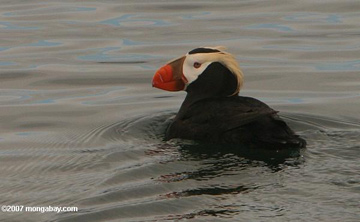Rats decimating Aleutian Islands’ ecology
Rats decimating Aleutian Islands’ ecology
mongabay.com
February 25, 2008
|
|
Rats are disrupting fragile ecosystems on the Aleutian Islands Archipelago, reports a new study published in the Proceedings of the National Academy of Sciences (PNAS).
Conducting surveys of 32 islands in the Aleutian Archipelago, a team led by the University of California at Santa Cruz’s Carolyn Kurle, found that by preying on seabird colonies, rats are affecting intertidal communities.
“Some of the affected birds–sea gulls and oystercatchers, in particular–are major predators of invertebrates in the intertidal zone. In their absence, the snails, limpets, and other grazers increase in abundance, eat more algae, and clear more space for other invertebrates to settle and grow,” explained a statement from UCSC. “The result is a shoreline practically stripped bare of the usual cover of fleshy algae.”
“Where there are no rats, we found plenty of birds, fewer invertebrates, and a lot more algal cover,” said Kurle, a graduate student at UCSC. “When you’re on an island with rats, there are so few birds it’s silent, in contrast to the cacophony on the islands without rats.”

|
Kurle and co-authors Donald Croll and Bernie Tershy say the study is an example of a trophic cascade.
“In a trophic cascade, you have an apex predator–in this case, the rat–and because of what that predator eats, you get a cascade of effects that go down through lower levels of the food chain,” Kurle explained. “This is a clear example of a trophic cascade that crosses between terrestrial and marine ecosystems.”
The research has led to the first rat eradication project in the Aleutian Islands. Beginning this summer, the Nature Conservancy, the U.S. Fish and Wildlife Service, and Island Conservation — a nonprofit organization founded by Croll and Tershy — will target rats on “Rat Island.”
“Our research is giving us a better understanding of the impacts of introduced rats, and by working directly with government agencies and nongovernmental organizations we’re able to do something about it,” said Croll.
Rats eat both chicks and adult birds. Other research, published in the February issue of Conservation Biology, shows that rats prey on at least 75 species of seabirds around the world.
This article is based on a news release from UCSC